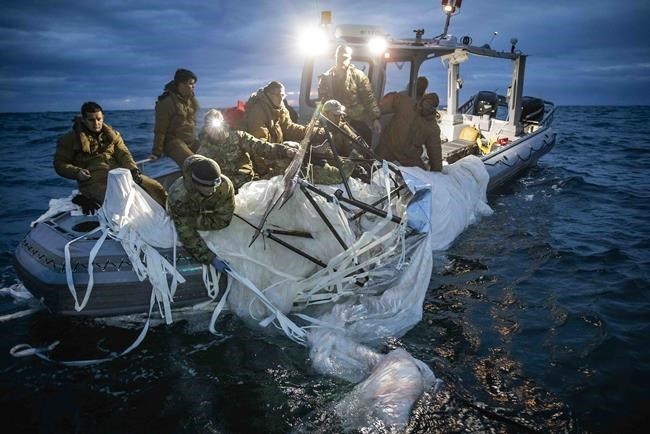WASHINGTON — A Canadian Coast Guard vessel churned across the Great Lakes to join the search for answers Monday after U.S. fighter jets shot down yet another mysterious object — the third such spectacle in as many days in the skies over North America.
The CCGS Griffon is also carrying RCMP investigators, as well as a drone team, to help locate debris that the White House confirmed is believed to be in the Canadian waters of Lake Huron, said Fisheries and Oceans Minister Joyce Murray.
Like the two preceding it, little is known about the object, which the binational continental defence system known as Norad tracked moving over Wisconsin on Sunday, and may have even originally detected high in the Canadian skies north of Montana.
"We will do our very best to secure this material so that we can understand better what the purpose and the operations are about," said Murray. Two Coast Guard helicopters are also standing by to assist if necessary, she added.
At the same time, Canadian Armed Forces personnel and RCMP investigators are also in a remote stretch of central Yukon as they search for the remnants of the object that was downed in that part of the world Saturday, again by a U.S. fighter pilot.
The Royal Canadian Air Force has deployed a CC-130H Hercules, two CC-138 Twin Otters, a CH-148 Cyclone, and a CH-149 Cormorant aircraft to support efforts to recover the debris.
"No matter what the threat, we will do whatever is necessary to protect Canadian airspace and sovereignty," said Public Safety Minister Marco Mendicino.
"It is in a stretch of terrain that is extremely challenging and difficult to access, which is why it needs to be carried out with a lot of care and attention to detail and forensics."
It is "likely," but also impossible to confirm, that the object at the bottom of Lake Huron was originally detected in Canadian airspace, Norad commander Gen. Glen VanHerck told a media briefing Sunday.
VanHerck said Norad first detected what appeared to be the object on Saturday at about 4:45 p.m. EST, about 110 kilometres north of the Canada-U.S. border. It crossed into U.S. airspace over Montana about an hour later, but fighter jets were unable to locate it.
Later that night, radar picked up a new signal approaching Wisconsin and Michigan, and continued to track it until President Joe Biden gave the order to shoot it down Sunday afternoon.
"It's likely, but we have not confirmed that the track that we saw at Wisconsin was … the same track in Montana," VanHerck said.
It was the third unidentified object to be shot down over North American airspace since the U.S. downed what it says was a Chinese surveillance balloon Feb. 4.
The first came Friday over the frozen waters of the Arctic Ocean, north of the Alaska coast and just 160 kilometres from the Canada-U.S. border. The second was downed Saturday over Yukon, with both Biden and Prime Minister Justin Trudeau consulting on the plan of action.
VanHerck confirmed in the briefing that part of the escalation for all of the sudden sightings is that Norad — a system originally designed to spot foreign aircraft and missiles — has recalibrated to better detect smaller, slower-moving objects
"If you have radars on all the time that were looking at anything from zero speed up to, say, (160 kilometres per hour), you would see a lot more information," VanHerck said.
"So, with some adjustments we've been able to get a better a categorization of radar tracks now. And that's why I think you're seeing these overall."
At the same time, the smaller and slower an object is, the harder it is to get a bead on, said John Kirby, the White House co-ordinator of the National Security Council.
"Slow-moving objects at high altitude with a small radar cross-section are difficult to detect on radar," he told the White House briefing.
The U.S. is convinced the original balloon was a Chinese surveillance device, but they know far less about the other three devices and their provenance, Kirby said. Academic, scientific or corporate research by privately or state-owned equipment remains a possibility.
"That said, because we have not yet been able to definitively assess what these most recent objects are, we acted out of an abundance of caution to protect our security, our interests and flight safety."
Trudeau, who happened to be in Yukon on Monday for a previously scheduled visit, waved off the suggestion that Norad should have detected all four of the incursions more quickly than it actually did, even after the recalibration.
"Actually, we are ensuring that we're monitoring together the airspace … we're working very, very closely together," Trudeau said, describing Norad as one of the only jointly commanded territorial defence systems in the world.
But he also acknowledged that the ongoing effort to upgrade and modernize Norad, a system that political and military leaders in both countries acknowledge is badly outdated, will be a top priority when he meets with Biden in person next month in Canada.
"This is a very serious situation that we are taking incredibly seriously," Trudeau said. "The importance of defending our territorial integrity, our sovereignty, has rarely been as important as it is now."
That didn't stop White House press secretary Karine Jean-Pierre from opening Monday's briefing with a public statement confronting the notion that the origins of the objects could be even further afield than first believed.
"There is no — again — no indication of aliens or extra-terrestrial activity with these recent takedowns," she said from the podium.
"It was important for us to say that from here, because we've been hearing a lot about it."
This report by The Canadian Press was first published Feb. 13, 2023.
James McCarten, The Canadian Press


